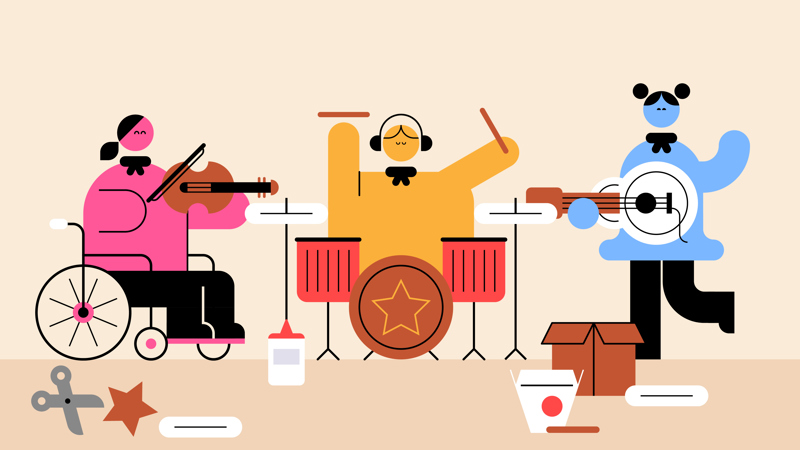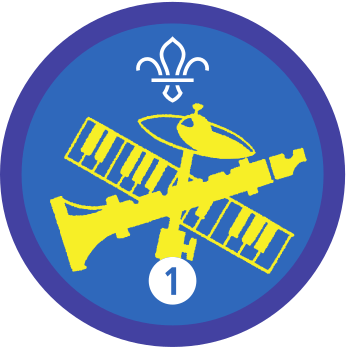
Music makers
You’ll need
- Elastic bands
- Balloons
- Clean items of recycling
- Dried food (for example, pasta, beans, rice)
- Coloured pens or pencils
- Sticky tape
- Scissors
- Buttons
- Beads
- Images of common instruments (optional)
- Ask the group if they can name any instruments or if they play any instruments.
- Explain that different instruments can be grouped together in categories called families. Can anyone name any of the instrument families?
-
- Woodwind (including flute, saxophone, clarinet, recorder, bassoon and oboe)
- Brass (including trumpet, trombone, tuba, French horn, cornet and bugle)
- Voice (Just like playing a piano or guitar, the voice can sing in different notes, and when we sing we’re making music. Get everyone to try singing a high note and a low note. They don’t need to actually sing a tune, but it will help them understand how the voice is an instrument.)
- String (including guitar, violin, viola, cello, bass, harp and dulcimer)
- Percussion (including drums, piano, cymbals, triangle, glockenspiel, timpani, bells and xylophone)
- Explain to the group that they are going to be making their own instruments out of junk and then play them together. They can pick their favourite instrument – whether it’s one they play or not.
- Allow participants to choose a sheet with instructions on how to make an instrument or they can make up their own.
- Provide the equipment needed to make the instruments and offer support wherever necessary. Remind everyone that their creation doesn’t need to work, it just needs to look like the real instrument.
- Once complete, ask the group to gather in a circle (or get two or three table groups to form circles together) with their instruments. Those who play an instrument in their spare time could present this instrument instead of their junk creation.
- Go around the circle so everyone can show the group their instrument and explain what it is. Why did they choose to make or play that instrument? Do they like the sound it makes? Is it their favourite instrument? If they play the instrument regularly, they can demonstrate some exercises they use to practise their instrument or talk about some of their favourite songs they play on it.
- Ask about some of their favourite songs they sing at Scouts. These could be campfire songs.
- From their ideas, choose three options that are simple call-and-response songs. Ask everyone to vote on their favourite, by playing any tune or noise on their instruments when you say the name of their favourite song.
- Get a tin, rubber bands, old pens, scissors, and a balloon or plastic bag.
- Cut the end of the balloon off or cut a circle out of the plastic bag large enough to wrap over the top of the tin.
- Use a rubber band to secure the balloon or plastic over the top of the tin.
- Make drumsticks by tying a rubber band on to the end of an old pen.
- Get a tissue box or cereal box, rubber bands, kitchen roll tube, sticky tape and scissors.
- If you’re using a cereal box, carefully cut a hole in the middle of the front of the box and tape the lid closed.
- Take a kitchen roll tube and cut slits around one end of the tube.
- Place the end you have cut slits into onto one of the shorter ends of the box.
- Stick it onto the box using sticky tape.
- Wrap rubber bands from the end of the box, over its middle and all the way to the end of the tube. If you can’t reach the end of the tube, just stretch the bands over the box.
- Tape the ends of the box and the tube to keep the rubber bands in place.
- Get a tissue box or cereal box, rubber bands, kitchen roll tube, sticky tape and scissors.
- If you’re using a cereal box, carefully cut a hole in the middle of the front of the box and tape the lid closed.
- Cut halfway down one end of a kitchen roll tube, Make another cut on the same end of the tube to create a flap.
- Cut this flap off, leaving a bit at the bottom. Keep the flap piece you cut off to one side.
- Stick the tube onto your box using sticky tape. The end you cut the flap from should go on the front of your box just in front of where the hole is. The other end that wasn’t cut is where you will hold your violin.
- Take the cardboard flap you cut from the tube earlier and roll it up from top to bottom.
- Stick it together so it stays rolled then stick the roll onto the end of the neck of your violin.
- Wrap rubber bands from the end box, over the middle of it all the way to the end of the tube. If you can’t reach the end of the tube, you can cut the rubber bands, stretch them over the front and tape the ends to secure them.
- Tape the ends of the box and the tube to keep the rubber bands in place.
- Use an old plastic pen for your bow.
- Get a small plastic bottle (with a lid), something to shake (such as rice, small pasta, old buttons or beads) and (optional) kitchen roll tube, sticky tape and scissors.
- Take the lid off the bottle and pour something to shake into the bottom half of the bottle.
- Tightly screw the lid back on the bottle.
Optional – to make a handle:
- Take a kitchen roll tube and cut slits around one end of the tube.
- Place the end you have cut slits into onto the top of the bottle and tape it down securely using sticky tape.
Reflection
While making your creations, discuss your instruments. What instrument are you making? Why did you choose that one?
Once you’ve played your crafted instrument, discuss why you enjoy playing it. Discuss how it feels to create music – does it make you feel happy? Energised?
Safety
All activities must be safely managed. You must complete a thorough risk assessment and take appropriate steps to reduce risk. Use the safety checklist to help you plan and risk assess your activity. Always get approval for the activity, and have suitable supervision and an InTouch process.
- Rubbish and recycling
All items should be clean and suitable for this activity.
- Scissors
Supervise young people appropriately when they’re using scissors. Store all sharp objects securely, out of the reach of young people.
- Food
Remember to check for allergies, eating problems, fasting or dietary requirements and adjust the recipe as needed. Make sure you’ve suitable areas for storing and preparing food and avoid cross contamination of different foods. Take a look at our guidance on food safety and hygiene.
Instead of presenting individually, table groups could share what they’ve done with another table before playing a tune together.
To make this easier, provide participants with images of common instruments or allow them to find an image online so they can see an example of what they are trying to create.
To make this harder, don't provide any instructions for how to make the instruments. Let them use their imagination and creativity to make their instruments.
For making string instruments, you could prepare the boxes in advance by cutting holes in them. Young people can work in pairs or small teams to make a larger instrument together and then take turns playing it.
All Scout activities should be inclusive and accessible.
Watch a live music performance or videos of a performance. What instruments can you see being played?
Invite your local Scout band to come and talk about their instruments, or go and watch one of their performances.
